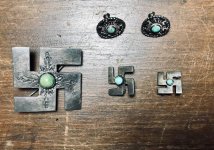When my time is done in RI this summer, I need to get my head into the disposition of a lot of Native American jewelry. My mother had collected/ invested/ accumulated in several shoeboxes full of this stuff. Mostly silver with turquoise and red coral. There are necklaces, cuffs, bracelets, rings and earrings. Some are sets of all 3, like necklace, bracelet and earrings all matching.
A lot of this came from Wyoming and the Southwest, with some pieces coming from transplanted Native Americans here in RI.
There are many squash blossom necklaces. Some being full chest coverage. All of this is 50 years plus old, or at least a good portion is.
I have to take pics and market this stuff, after I determine a value.
Any suggestions? Anybody know a guy? I have been told that some of these necklaces could be worth thousands.
My goal would be to sell this off to collectors, not roadside dealers in a camper.
Thoughts?
Thanks
A lot of this came from Wyoming and the Southwest, with some pieces coming from transplanted Native Americans here in RI.
There are many squash blossom necklaces. Some being full chest coverage. All of this is 50 years plus old, or at least a good portion is.
I have to take pics and market this stuff, after I determine a value.
Any suggestions? Anybody know a guy? I have been told that some of these necklaces could be worth thousands.
My goal would be to sell this off to collectors, not roadside dealers in a camper.
Thoughts?
Thanks
Last edited:


